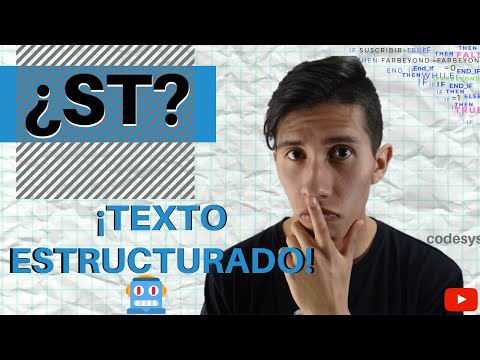Structured text: What is it and how does it work in a PLC?
Introduction:
In the world of industrial automation, PLCs (Programmable Logic Controllers) play a crucial role. These devices are capable of controlling and monitoring industrial processes efficiently. One of the most important aspects of PLC programming is structured text. In this article we will explore what structured text is and how it works in a PLC. We will discover its advantages and why it is an essential tool for PLC programmers. If you want to learn more about how to optimize your PLC programs, keep reading!
What is structured text in PLC
Structured text: What is it and how does it work in a PLC?
Structured text is a programming language used in programmable logic controllers (PLC) to program and control the operation of automated systems. This language is based on a set of rules and conventions that allow the code to be organized and structured in a clear and readable way.
PLC structured text is made up of a series of instructions that tell the controller what actions to take. These instructions are grouped into blocks of code that are executed sequentially, allowing you to control the flow of program execution.
One of the most important characteristics of structured text is its ability to handle variables. These variables can store numeric, logical, or text values, and are used to store information and perform mathematical or logical operations. Structured text allows you to declare and use variables in an efficient and easy-to-understand way.
In addition, structured text in PLC offers a wide range of instructions that allow operations such as assigning values to variables, executing loops or making conditional decisions. These instructions allow you to create more complex and functional programs, adapted to the specific needs of each system.
PLC structured text is widely used in industry to program automated systems in different sectors, such as manufacturing, energy or home automation. Its clear, readable structure makes it easy to program and maintain systems, reducing errors and improving production efficiency.
What is structured text
Structured text: What is it and how does it work in a PLC?
Structured text is a programming language used in programming programmable logic controllers (PLC). It is a graphical programming language used to describe the logic and functions of a PLC. Unlike other programming languages, structured text is based on a function block structure, making it easier to understand and debug.
A PLC is an electronic device used to control industrial processes and machinery. It uses sensors and actuators to receive and send signals, and structured text is used to program the logic that controls the behavior of the PLC.
Structured text uses a combination of programming elements such as IF-THEN-ELSE, FOR, WHILE and other control structures to define the actions the PLC should take based on given inputs and conditions. These structures are graphically represented as function blocks in PLC programming software.
The advantage of structured text is that it allows for more structured and readable programming. Function blocks can be reused and can be connected together to form a flowchart that represents the logic of the program. This makes it easier to debug and maintain the program.
Additionally, structured text allows for modular programming, meaning that subroutines and functions can be created that can be called from different parts of the program. This makes it easier to reuse code and create more efficient and scalable programs.
How to use a case in structured text
Structured text: What is it and how does it work in a PLC?
Structured text is a programming language used in programmable logic controllers (PLCs) to create automation programs. It is based on a series of instructions that allow controlling the operation of electronic systems in an industrial plant.
What is a PLC?
A programmable logic controller (PLC) is an electronic device used to control and automate processes in industry. It is composed of a central processing unit, digital and analog inputs and outputs, and a communication interface.
How does structured text work in a PLC?
Structured text is used to program the behavior of the PLC. Allows you to write sequences of instructions that tell the controller how to operate in response to different conditions. These instructions are organized into blocks of code that are executed sequentially.
What is a case in structured text?
A case in structured text is a control structure that is used to make decisions based on different conditions. It is used when there are multiple possible options and a specific sequence of instructions must be executed for each option.
How do you use a case in structured text?
To use a case in structured text, the following steps must be followed:
1. Define the different options: The different conditions or values that can occur and for which a specific sequence of instructions must be executed must be identified.
2. Write the case: The “Case” control structure is used followed by the variable or expression to be evaluated. The different options are then defined using the keyword “Option” followed by the value to be compared with the variable or expression.
3. Write the instructions for each option: For each defined option, the instructions that will be executed if the condition is met must be written. These instructions are written after the keyword "Do."
4. End the case: The keyword “EndCase” is used to indicate the end of the case.
Case example in structured text:
Suppose we want to control the operation of a motor based on different conditions.
So there you have it, my friend! Now you know everything about structured text in a PLC. It's like the secret sauce that makes everything work perfectly. Without it, everything would be a computer disaster. So remember, if you want your PLCs to dance to the rhythm of efficiency, make sure you have a good structured text. Don't forget to give that touch of flavor to your electronic projects!




Post Comment